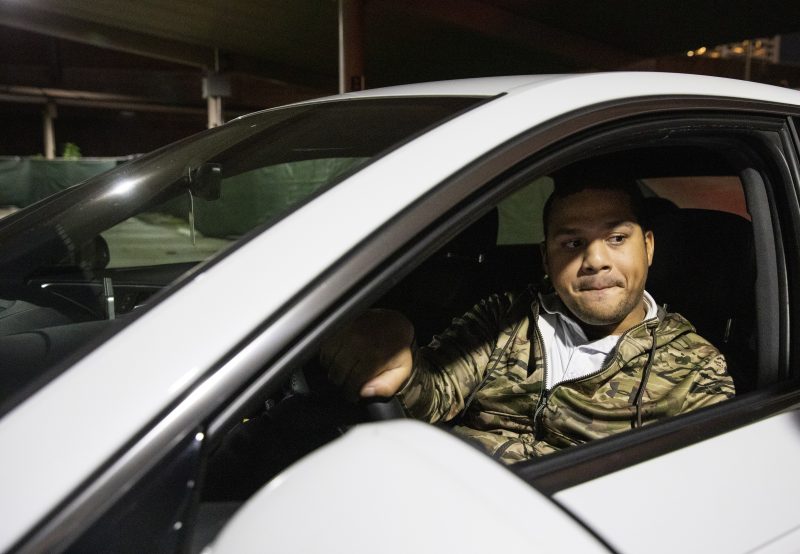Parking lots offer safe haven for homeless Californians
Cameron Jones, a 26-year-old Marine Corps veteran who served in Afghanistan, lost his apartment and is now sleeping in his car in a “safe parking” lot in Los Angeles (Kyle Grillot)
Los Angeles (AFP) – It’s a chilly winter evening in Los Angeles as Cameron Jones maneuvers his white sports car into an open-air parking lot and picks a secluded spot where he can recline his seat and call it a night.
“I lost my apartment about 10 days ago because I couldn’t afford the $2,200 rent and was told this is a safe place to be until I get back on my feet,” said Jones.
“I can sleep soundly here without having to keep waking up at night and looking over my shoulder,” added the 26-year-old Marine Corps veteran, who served in Afghanistan and now works for a company that sells solar panels.
Jones joined a health club in order to shower every morning before going to work. His suit hangs in the back seat, ready for use.
Within an hour or so, about a dozen other vehicles — some with children inside — fill the lot that is part of a growing number of so-called “safe parking” areas in California and other US states.
Half a dozen such lots monitored by security guards have sprung up in the Los Angeles area in the last year, offering a temporary safe haven to some of the more than 15,500 people in the region who live in their vehicles.
One “safe parking” is located at the back of a church, another at a synagogue and a third at the sprawling campus operated by the US Department of Veterans Affairs.
Portable toilets and hand-washing stations are available to the vehicle dwellers who must fill out an application before being granted access to the lots.
– ‘I feel safe here’ –
Nearly 554,000 people in the United States were homeless in 2017, according to the US Department of Housing and Urban Development (HUD).
About 25 percent of them — or 134,000 — lived in California, the highest number of any state.
California also has the highest rate of so-called “unsheltered” homeless — meaning people who are living in vehicles, abandoned buildings, parks or on the street, according to HUD.
In Los Angeles county alone, there are some 53,000 homeless people, a huge increase from 2010, when the number stood at about 38,700, according to the Los Angeles Homeless Services Authority.
Carlos Gonzalez Jr is a 60-year-old US Army veteran who fell on hard times after suffering an elbow injury and has been living in a mobile home for the past couple years.
For him, the safe parking program means he does not have to constantly move his car or face harassment.
“There are bad people out there and I feel safe here,” he told AFP as he parked his RV at the Veterans Affairs lot near LA’s upscale Westwood neighborhood and prepared to go to sleep.
“Here I can sleep without being concerned about someone breaking into my car,” Gonzalez added, speaking over the constant din of cars racing along a nearby highway.
Similar programs have been implemented elsewhere in California — including in the San Francisco Bay area — where skyrocketing housing prices have increasingly pushed low-income residents onto the streets.
“We have a school teacher who uses one of our lots and she said the rent got higher than she could afford and she wound up in her car,” said Ira Cohen, who co-founded the Safe Parking LA program with his wife Pat.
“The economics are such that some people can no longer afford to live indoors… and some are lucky to have a vehicle to provide a home for themselves.”
– ‘This didn’t happen overnight’ –
Experts say the lack of affordable housing and soaring home costs are the key reasons for the dramatic spike in homelessness.
They blame federal, state and local authorities for failing to develop a sound strategy to address a crisis that was years in the making.
“This didn’t happen overnight,” said Gary Painter, who heads the Homelessness Policy Research Institute at the University of Southern California.
“Rents in Los Angeles have been going up faster than people’s incomes for quite a few decades… and I think it’s reasonable to say that we reached our breaking point in the last three years in terms of that leading to people living on the streets.”
Painter said although there has been a massive influx of funding for new housing, shelters and outreach programs in recent years, the state was unlikely to turn the corner any time soon, given the scale of the problem.
In the meantime, programs like Safe Parking LA are gaining in popularity as authorities seek interim solutions.
“If you spoke to me a couple years ago and told me that I would be in this situation, I probably would have laughed at you,” said Jones.
“I thought I was living the American Dream.”
Disclaimer: This story is published from a syndicated feed. Siliconeer does not assume any liability for the above story. Validity of the above story is for 7 Days from original date of publishing. Content copyright AFP.


